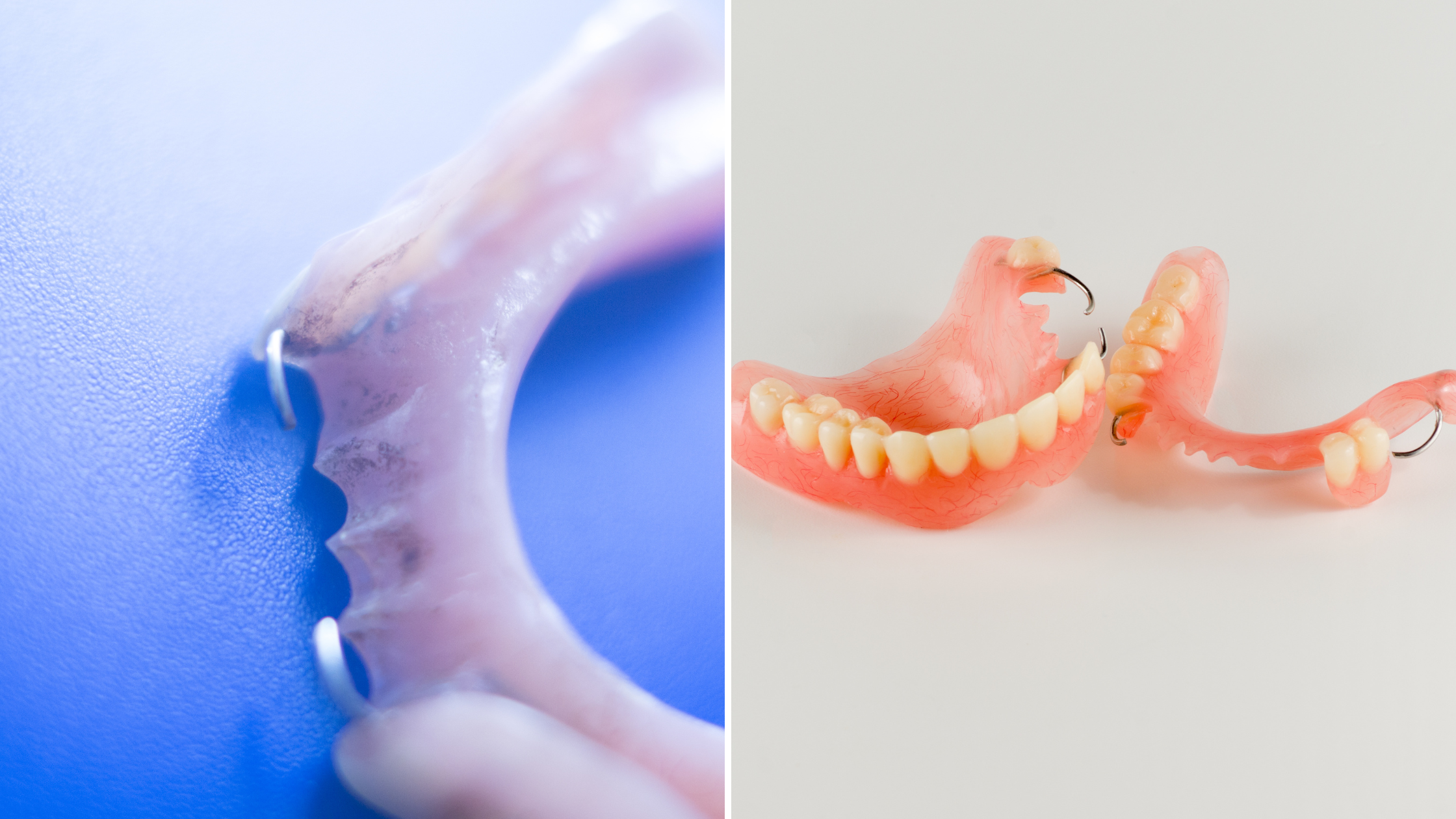1. Setting the Stage: The Need for Dentures
Briefly explain why people might require dentures
People might require dentures for a variety of reasons, encompassing both functional and aesthetic concerns. Here are some of the primary factors that drive the need for dentures:
Tooth Loss: The most obvious reason for needing dentures is the loss of teeth due to aging, decay, or injury. Missing teeth can make it difficult to eat certain foods, speak clearly, and maintain facial structure.
Oral Health: Missing teeth can cause remaining teeth to shift and lead to jaw alignment issues. Dentures can help maintain the structure of your mouth, reducing strain on your jaw and improving oral health.
Quality of Life: Eating and speaking with missing teeth can be uncomfortable and awkward. Dentures can improve these basic daily activities, increasing your quality of life.
Aesthetics: Missing teeth can cause self-consciousness about appearance, affecting one’s confidence and social interactions. Dentures help restore a natural-looking smile, providing a boost in self-esteem.
Nutrition: Missing teeth can make it challenging to eat a balanced diet, as chewing certain foods becomes difficult. Dentures can make it easier to eat a variety of foods, leading to better nutrition.
Advanced Dental Issues: In some cases, teeth may be so damaged due to decay or disease that extraction and replacement with dentures become the best option for overall health.
Economic Factors: While there are several options for replacing missing teeth, including implants and bridges, dentures often present a more economical solution, especially for those missing multiple teeth.
Convenience: Dentures are generally easy to clean and maintain, making them a convenient choice for many people, especially those who might struggle with the upkeep of other dental appliances.
Adaptability: Dentures come in various forms, such as full or partial, giving options to those who may not require a full set of replacement teeth.
Understanding the reasons behind the need for dentures can guide you in making an informed decision between different types, such as partial chrome dentures and acrylic options, to best suit your individual circumstances.
2. The Core Differences: Partial Chrome vs. Acrylic
Material Composition
· Partial Chrome Dentures: These are made from a chromium-cobalt alloy, which makes them both strong and lightweight. The metal framework is often less visible and can be thinner, providing a more natural look.
· Acrylic Dentures: These are primarily made from acrylic resin and sometimes have a metal framework for added strength. They are more flexible but may be bulkier than their chrome counterparts.
Durability
· Partial Chrome Dentures: Known for their durability, chrome dentures are resistant to wear and tear and less likely to break if dropped. The material’s strength also allows for a thinner design, contributing to less gum coverage and a more natural feel.
· Acrylic Dentures: While still relatively durable, acrylic dentures are generally considered less durable than chrome. They can be prone to chipping or cracking and may need to be replaced more frequently than chrome dentures.
Comfort
· Partial Chrome Dentures: Many find chrome dentures to be more comfortable due to the thinner framework and less gum coverage. This reduced bulk allows for a better fit and less movement, which can mean less irritation and discomfort during daily activities like eating and speaking.
· Acrylic Dentures: Acrylic dentures can be more adaptable initially, and easier to adjust to. However, their bulkier design can make them less comfortable over time, and they may require more frequent adjustments to maintain a comfortable fit.
Understanding these core differences can help you make an informed decision between partial chrome and acrylic dentures, taking into account your specific needs and priorities.
3. Consider Your Lifestyle
Eating Habits
Partial Chrome Dentures: These are generally more stable and offer a firmer bite, which may be beneficial if you enjoy eating harder or crunchier foods.
Acrylic Dentures: While they can handle most types of food, they may be less stable when biting into harder items, which could limit your food choices slightly.
Physical Activities
· Partial Chrome Dentures: The durability and secure fit make these a good choice for people who lead an active lifestyle, as they are less likely to break or become dislodged during physical activities.
· Acrylic Dentures: While they can be a viable option for an active lifestyle, they are generally less durable and may require more frequent adjustments or replacements, especially if you’re engaged in high-impact activities.
Social Engagements
Partial Chrome Dentures: Because they tend to have a more natural look and feel, these could be more comfortable for long social engagements, allowing for easier speaking and less worry about the dentures shifting.
Acrylic Dentures: While still effective, the potential for a bulkier fit may make long social interactions slightly less comfortable, especially if you’re concerned about the appearance of your smile or the possibility of the dentures moving.
Your lifestyle plays a significant role in the type of dentures that will suit you best. Considering your eating habits, physical activities, and social engagements can help you decide between partial chrome and acrylic options effectively.
4. Durability and Longevity
Life Span of Each Type
Partial Chrome Dentures: These are known for their durability and can often last upwards of 10 to 15 years with proper care. The material is highly resistant to wear and tear, contributing to a longer life span.
Acrylic Dentures: Typically, acrylic dentures have a shorter life span, ranging from 5 to 10 years. The material is more susceptible to cracks, chips, and wear, meaning it might need replacement sooner than chrome dentures.
Need for Replacements or Repairs
· Partial Chrome Dentures: Given their durability, chrome dentures often require fewer repairs and replacements over their lifetime. However, they may be more expensive to fix if they do break, given the material and construction.
· Acrylic Dentures: These tend to require more frequent adjustments and repairs due to their less durable material. Cracks and chips are more common, and in some cases, a replacement might be more cost-effective than a repair.
Understanding the durability and longevity of each type can help you make a more informed decision. If you’re looking for a long-term solution with fewer maintenance requirements, partial chrome dentures may be the better option. However, if you’re looking for a less expensive initial investment and are okay with the potential need for more frequent repairs or replacements, acrylic dentures might be more suitable for you.
5. Comfort and Daily Wear
Feel in the Mouth
· Partial Chrome Dentures: These dentures are generally lighter and less bulky, contributing to a more natural feel in the mouth. Their metal framework offers a snug fit, which can make them feel more like natural teeth.
· Acrylic Dentures: These can feel bulkier due to the material and construction, which might take some time to get used to. They can sometimes feel less stable, which may cause discomfort during chewing or speaking.
Ease of Adaptation
· Partial Chrome Dentures: The design and snug fit often make these easier to adapt to. The reduced bulk and more natural feel can mean a shorter adjustment period.
· Acrylic Dentures: While they may initially feel strange due to their bulk, the softer material can make them easier to adapt to for some people. However, they may require more frequent adjustments for a comfortable fit over time.
Both types of dentures offer varying degrees of comfort and ease of adaptation. Partial chrome dentures usually provide a more natural feel and require less time to adjust to, making them a convenient choice for daily wear. Acrylic dentures, while possibly requiring a longer adjustment period, can be more forgiving initially, especially for those new to wearing dentures. Your personal comfort preferences will play a key role in deciding between these two options.






